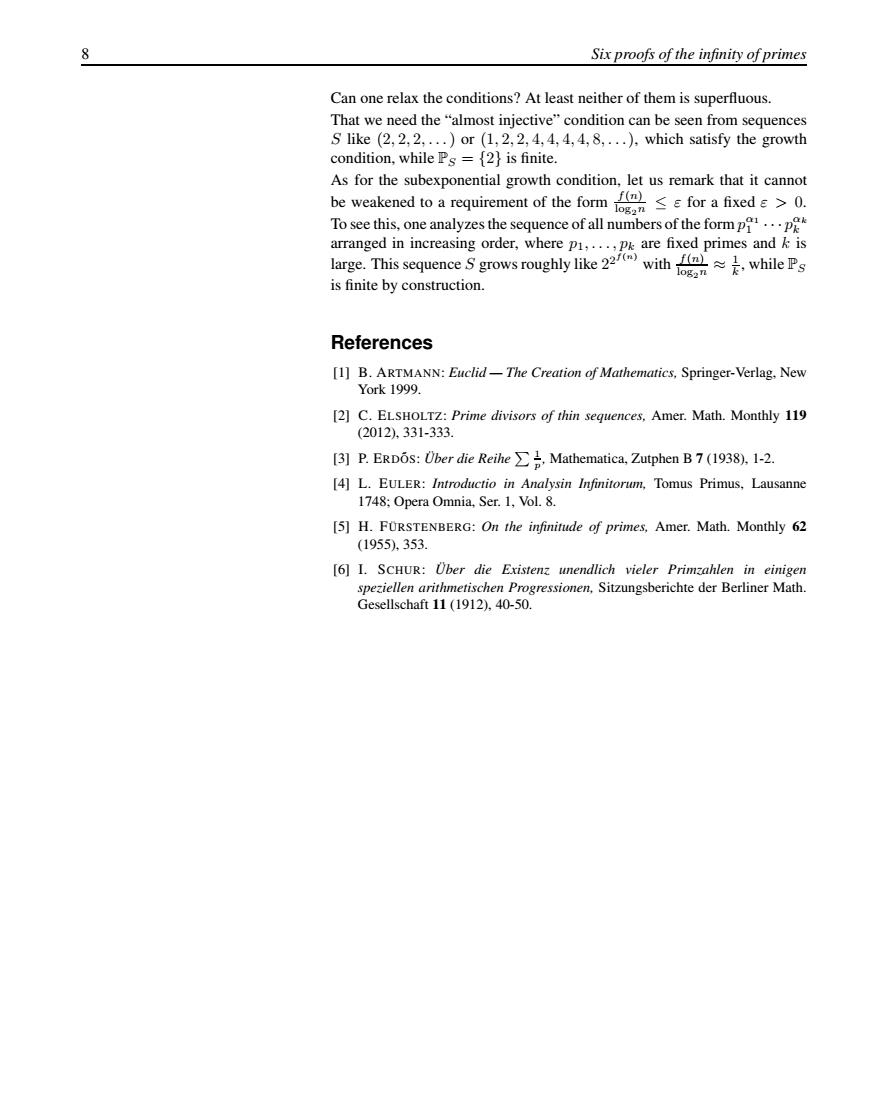正在加载图片...

8 Six proofs of the infinity of primes Can one relax the conditions?At least neither of them is superfluous. That we need the "almost injective"condition can be seen from sequences S like (2,2,2,...)or (1,2,2,4,4,4,4,8,...),which satisfy the growth condition,while Ps =[2}is finite. As for the subexponential growth condition,let us remark that it cannot be weakened toa requirement of the formfor a fixed To see this,one analyzes the sequence of all numbers of the formpp arranged in increasing order,where p1,...,Pk are fixed primes and k is large.This sequence S grows roughly like withwhileP log2n is finite by construction. References [1]B.ARTMANN:Euclid-The Creation of Mathematics,Springer-Verlag,New York 1999 [2]C.ELSHOLTZ:Prime divisors of thin sequences,Amer.Math.Monthly 119 (2012).331-333. [3]P.ERDOs:Uber die ReiheMathematica.Zutphen B7(1938).1-2. [4]L.EULER:Introductio in Analysin Infinitorum,Tomus Primus,Lausanne 1748;Opera Omnia,Ser.1,Vol.8. [5]H.FURSTENBERG:On the infinitude of primes,Amer.Math.Monthly 62 (1955).353. [6]I.SCHUR:Uber die Existenz unendlich vieler Primzahlen in einigen speziellen arithmetischen Progressionen,Sitzungsberichte der Berliner Math. Gesellschaft 11(1912),40-50.8 Six proofs of the infinity of primes Can one relax the conditions? At least neither of them is superfluous. That we need the “almost injective” condition can be seen from sequences S like (2, 2, 2,...) or (1, 2, 2, 4, 4, 4, 4, 8,...), which satisfy the growth condition, while PS = {2} is finite. As for the subexponential growth condition, let us remark that it cannot be weakened to a requirement of the form f(n) log2n ≤ ε for a fixed ε > 0. To see this, one analyzes the sequence of all numbers of the form pα1 1 ··· pαk k arranged in increasing order, where p1,...,pk are fixed primes and k is large. This sequence S grows roughly like 22f(n) with f(n) log2n ≈ 1 k , while PS is finite by construction. References [1] B. ARTMANN: Euclid — The Creation of Mathematics, Springer-Verlag, New York 1999. [2] C. ELSHOLTZ: Prime divisors of thin sequences, Amer. Math. Monthly 119 (2012), 331-333. [3] P. ERDOS˝ : Über die Reihe 1 p , Mathematica, Zutphen B 7 (1938), 1-2. [4] L. EULER: Introductio in Analysin Infinitorum, Tomus Primus, Lausanne 1748; Opera Omnia, Ser. 1, Vol. 8. [5] H. FÜRSTENBERG: On the infinitude of primes, Amer. Math. Monthly 62 (1955), 353. [6] I. SCHUR: Über die Existenz unendlich vieler Primzahlen in einigen speziellen arithmetischen Progressionen, Sitzungsberichte der Berliner Math. Gesellschaft 11 (1912), 40-50.�